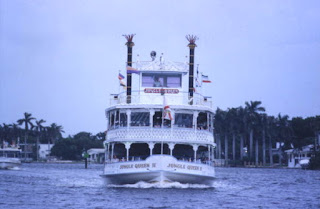 |
| Fort Lauderdale's beach hotels |
By Jane Feehan
Hotels were springing up all over South Florida during the 1950s, a decade it was deemed one of the most popular vacation stops in the country. A front-page story in the Miami Herald (Jan. 16, 1956) about a hotel exposition in New York City probably caught the eye of “vacationists” and hoteliers alike. It offered a glimpse into hotels of the future.
The future is here and some of the predictions were right on the mark … and some may make us laugh.
Hotels would be run by“automatic service controls” or electronic technology. With it:
- Guests would be assigned their room by a computer-staffed registration desk.
- Luggage will be delivered to rooms via conveyor belts.
- Guest rooms will be a “science fiction dream.” A bedside console, nerve center for countless robotic aids, will be used to control temperature and lighting. It will also serve as a control center for radio, TV and a hi-fi sound system. From the console, a guest will read stock quotes or morning news summaries, including the weather. There, a guest will also retrieve messages, make phone calls and handle dictation, select a time to be awakened, and automatically arrange room service.
- Pneumatic tubes will be used to deliver standard items like ice and food.
- Staffers will still be needed to add an element of friendliness; there will be plenty of that because they won't be overworked, overtired.
Most of this technology has become part of standard hotel operations but, thankfully for staffers looking for tips, not everything has materialized. And those pneumatic tubes … perhaps a food replicator is in store?
The American Hotel and Lodging Association sheds light on
some actual hotel milestones. Some were anticipated in that 1956 exposition;
others never made it to the first rungs of speculation. Reality may be more
interesting:
1950s - Quality Courts becomes the first to offer
innovations such as wall-to-wall carpeting, daily change of linens, 24-hour
desk service, and in-room telephones.
1950s - The first black and white television
sets were placed in hotel lobbies or other common areas.
1958 - Sheraton created the first automated, electronic
reservations system.
1969 - Westin is the first hotel chain to
implement 24-hour room service.
1970 - Sheraton pioneered an 800 number for toll-free
reservation calls.
1975 The first extended-stay property,
the Residence Inn, was built in Wichita, Kansas.
1991 - Hotel Triton in San Francisco opened doors to
the first celebrity suite.
1994 - Promus becomes the first hotel company to
provide hotel information via the Internet.
1995 - Choice Hotels launches Choicehotels.com,
the first website in the lodging industry to offer
real-time access to a CRS.
And no replicators ... yet.
Copyright © 2013. All rights reserved. Jane Feehan.
Tags: Hotel history, South Florida history, hotels of the future, hotel technology, historical researcher, Florida history







